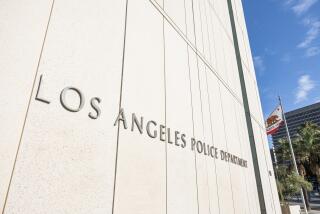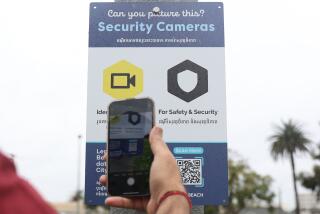LAPD Liaisons to Stop Crime Map Distribution
- Share via
The Los Angeles Police Department is ordering its community liaison officers to stop distributing detailed crime maps, saying they are so specific they could compromise enforcement efforts and even indicate where crime victims or witnesses live.
Top LAPD officials said Wednesday that the color-coded maps, which are often photocopied and handed out at neighborhood meetings, were never intended to be made public.
Public distribution of the maps “has never been the department’s policy,” said Deputy Chief Michael J. Bostic, commander of the Valley Bureau. And some well-meaning senior lead officers “got a little too specific about what they were releasing. There are victim-safety issues.”
Some community leaders said Wednesday they thought the move was, at least in part, prompted by concerns that private security companies were using them to boost business and that they were influencing real estate transactions.
They called the move to keep the maps secret the latest effort by Police Chief Bernard C. Parks to whittle away at community-based policing programs, which they credit with reducing crime in their neighborhoods.
“This is just crazy. It’s just contrary to everything [previously] promoted by the LAPD,” said Tony Lucente, president of the Studio City Residents Assn. “We have members who come to [our] meeting every month just to obtain those maps. Lack of information is a handicap.”
Lucente also questioned whether the maps were specific enough to hamper crime fighting or endanger citizens.
Parks could not be reached for comment.
The policy against public distribution of the maps--with one symbol indicating the location of a burglary, for example, and another for a car theft--is just now being worked out. Studio City homeowners heard the news at a meeting Tuesday night from a senior lead officer who is based in the North Hollywood Division.
Some divisions in the city have been distributing the maps for more than a year--sometimes even posting them on the Internet--but Bostic said he didn’t learn about the practice until March, when along with Parks he began to plan a Valley-wide police newsletter.
Plotted at police headquarters downtown and then analyzed at the 18 LAPD divisions, the maps are intended to help illustrate crime patterns. But they have also been used for other purposes, police officials said.
A private security company made photocopies of one map and distributed it with promotional materials in a neighborhood that had seen several recent crimes, said Capt. Richard Wahler of the North Hollywood Division.
Valley Bureau officers were receiving several calls a day on some days from real estate companies and security firms requesting maps of certain areas, Det. Woodrow Parks said.
“It was getting unmanageable and taking time away from what we were supposed to do,” he said.
In addition to concerns over their uses by businesses, police officials said the maps can be misleading and unfair if simply handed out without explanation.
“A cluster of crime can appear and disappear in a few weeks, and [a map] of it may cause unnecessary fear,” Wahler said.
Officers will still be allowed to distribute information on the number and types of crimes committed in a neighborhood, so long as they aren’t plotted on maps.
Even so, the recent decision has once again put some neighborhood activists at odds with Parks and his approach to community-based policing. Last fall, Parks got an earful of complaints from residents over his plan to put senior lead officers back on the street as patrol officers and mentors for rookie cops.
Residents criticized that plan, charging that it would sever their ties with officers and reduce police responsiveness. Word of the map ban elicited similar reactions.
“We believe community policing is on its way out, and that that relationship is being severed by Parks,” said Ellen Bagelman, president of the Lake Balboa Homeowners Assn. and a resident of Van Nuys.
More to Read
Sign up for Essential California
The most important California stories and recommendations in your inbox every morning.
You may occasionally receive promotional content from the Los Angeles Times.










